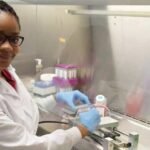Escherichia coli, commonly known as E. coli is a gram-negative, rod-shaped bacterium widely studied in microbiology. It belongs to the family Enterobacteriaceae and is predominantly found in the intestines of humans and warm-blooded animals. It plays a crucial role in gut health.
Table of Contents
However, some strains are pathogenic and cause various infections and illnesses. This bacterium is a model organism for scientific research, particularly in molecular biology and genetics.

Morphology and Structure
E. coli exhibits the following key characteristics:
– Shape: Rod-shaped bacillus, measuring 1–2 µm in length.
– Gram Stain: Gram-negative due to the thin peptidoglycan layer in its cell wall.
– Flagella: Most strains are motile, possessing peritrichous flagella, which means flagella are distributed around the surface of the cell.
– Capsule: Some strains have a polysaccharide capsule that helps in resisting phagocytosis.
– Fimbriae: They possess fimbriae (pili) that aid in adhesion to surfaces and cells.
– Spores: Non-sporulating.
The outer membrane contains lipopolysaccharides (LPS), which act as endotoxins and are a key virulence factor in pathogenic strains.
Classification of E. coli
Based on its behavior and the impact on hosts, E. coli can be classified into two broad categories:
1. Non-pathogenic Strains: Commonly found in the gut, contributing to digestion, vitamin production (e.g., Vitamin K), and preventing colonization by harmful bacteria.
2. Pathogenic Strains: These strains cause illness and are categorized into different pathotypes, including:
– Enteropathogenic E. coli (EPEC): Causes diarrhea, especially in infants in developing countries.
– Enterotoxigenic E. coli (ETEC): Known for causing traveler’s diarrhea by producing heat-labile and heat-stable toxins.
– Enterohemorrhagic E. coli (EHEC): Produces Shiga toxins, leading to hemorrhagic colitis and hemolytic uremic syndrome (HUS); the most notorious strain is E. coli O157:H7.
– Enteroinvasive E. coli (EIEC): Invades and destroys intestinal epithelial cells, causing dysentery-like illness.
– Enteroaggregative E. coli (EAEC): Adheres to the intestinal mucosa, causing prolonged diarrhea.
– Uropathogenic E. coli (UPEC): Causes urinary tract infections (UTIs).

Growth Conditions
E. coli grows in a variety of environments under both aerobic and anaerobic conditions. It grows well on basic microbiological media, such as nutrient agar, LB agar, or MacConkey agar. Key growth parameters include:
– Temperature: Optimal growth occurs at 37°C, though some strains can grow in a range from 15°C to 45°C.
– pH: Optimal pH is around 6.5–7.5.
– Oxygen: Facultative anaerobe — can grow in the presence or absence of oxygen.
– Nutrient Requirements: Requires simple nutrients such as glucose or lactose for fermentation.
Role in Biotechnology
E. coli is widely used in genetic engineering and biotechnology due to its simple genetics, fast growth, and ability to express foreign genes. Applications include:
1. Recombinant DNA Technology: E. coli is commonly used as a host organism for cloning and expressing genes from other organisms.
2. Protein Production: Many commercially important proteins, such as insulin and human growth hormone, are produced using recombinant E. coli.
3. Model Organism: Its well-understood genetics makes E. coli an ideal model organism for studying gene function and regulation.
4. CRISPR Technology: Research on E. coli has played a crucial role in developing CRISPR-Cas systems for genome editing.
Laboratory Identification
In the lab, E. coli can be easily identified through various biochemical tests:
– Lactose Fermentation: E. coli ferments lactose, producing acid and gas, a key distinguishing feature on MacConkey agar.
– IMViC Tests: These tests (Indole, Methyl Red, Voges-Proskauer, and Citrate) are crucial for differentiating E. coli from other Enterobacteriaceae:
– Indole: Positive
– Methyl Red: Positive
– Voges-Proskauer: Negative
– Citrate: Negative
– Oxidase Test: Negative.
– Catalase Test: Positive.
– Serotyping: Pathogenic strains can be identified by serotyping based on O (somatic) and H (flagellar) antigens.

Microlookup is a free web app built for microbiologists, students, and curious learners. Simply type the name of a microorganism and access key details like morphology, pathogenicity, growth conditions, and more.
Please visit the site and explore!
Read: Bacterial Morphology

